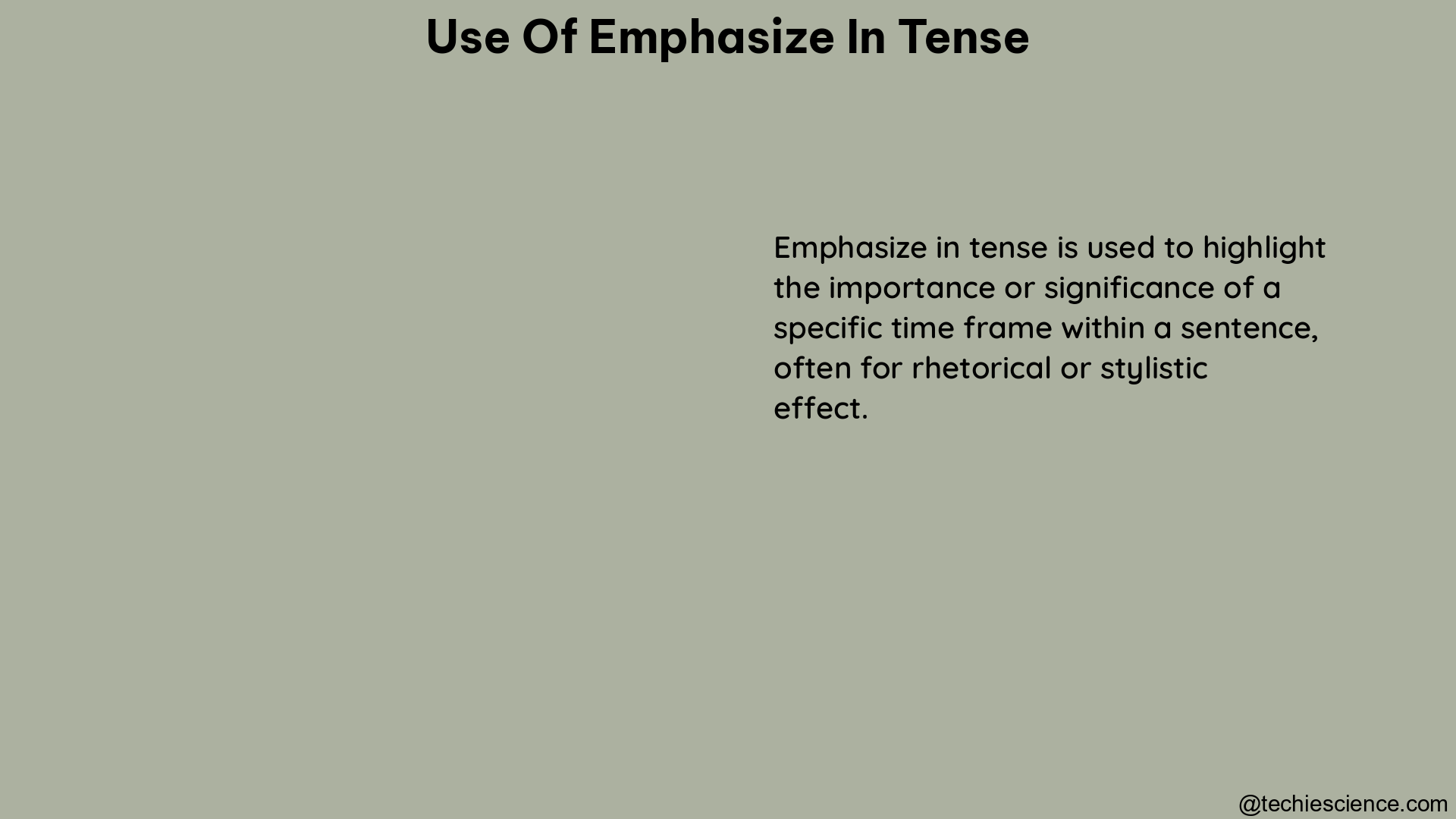The strategic use of emphasis in tense can significantly enhance the clarity and impact of your written communication. By carefully placing words or phrases, you can draw attention to specific parts of a sentence, conveying nuanced meaning and emphasizing key points. In this comprehensive guide, we’ll explore the advanced techniques and grammatical specifications for effectively using emphasis in various tense forms.
Present Tense
Simple Present Tense
In the simple present tense, emphasis can be added using the auxiliary verb “do.” This technique helps to highlight the action being performed. For example:
- “I do read newspapers every day” (emphasizing the action of reading)
- “She does enjoy her morning jog” (emphasizing the enjoyment of the activity)
The use of “do” or “does” in these sentences puts a stronger focus on the verb, making the action more prominent.
Present Progressive Tense
When using the present progressive tense, emphasis can be achieved through strategic word placement and the use of adverbs. This approach helps to highlight the ongoing nature of the action. For example:
- “I am emphasizing the importance of this task” (emphasizing the ongoing action)
- “She is carefully considering the options” (emphasizing the careful consideration)
By positioning the emphasized words in the sentence, you can draw the reader’s attention to the specific aspect of the action that you want to highlight.
Past Tense

Simple Past Tense
In the simple past tense, emphasis can be added using the auxiliary verb “did.” This technique helps to underscore the completion of the action. For example:
- “I did read the newspapers yesterday” (emphasizing the completed action)
- “They did complete the project on time” (emphasizing the successful completion)
The use of “did” in these sentences puts a stronger focus on the verb, emphasizing the past action.
Past Progressive Tense
When using the past progressive tense, emphasis can be achieved through strategic word placement and the use of adverbs. This approach helps to highlight the ongoing nature of the action in the past. For example:
- “I was emphasizing the importance of this task” (emphasizing the ongoing action in the past)
- “She was diligently working on the project” (emphasizing the diligent effort in the past)
By positioning the emphasized words in the sentence, you can draw the reader’s attention to the specific aspect of the past action that you want to highlight.
Future Tense
Simple Future Tense
In the simple future tense, emphasis can be added using adverbs or italics. This technique helps to underscore the certainty or importance of the future action. For example:
- “I will definitely read the newspapers tomorrow” (emphasizing the future action)
- “I will read the newspapers tomorrow” (emphasizing the verb using italics)
The use of adverbs like “definitely” or the emphasis on the verb through italics can help to highlight the future action.
Perfect and Continuous Tenses
Present Perfect Tense
When using the present perfect tense, emphasis can be achieved through strategic word placement and the use of adverbs. This approach helps to highlight the ongoing action with a connection to the present. For example:
- “I have been emphasizing the importance of this task” (emphasizing the ongoing action with a connection to the present)
- “She has consistently demonstrated her commitment to the project” (emphasizing the consistent action)
By positioning the emphasized words in the sentence, you can draw the reader’s attention to the specific aspect of the present perfect action that you want to highlight.
Past Perfect Tense
In the past perfect tense, emphasis can be added using the auxiliary verb “had.” This technique helps to underscore the completed action in the past. For example:
- “I had emphasized the importance of this task” (emphasizing the completed action in the past)
- “They had already finished the project before the deadline” (emphasizing the prior completion)
The use of “had” in these sentences puts a stronger focus on the verb, emphasizing the past action.
Future Perfect Tense
When using the future perfect tense, emphasis can be achieved through strategic word placement and the use of adverbs. This approach helps to highlight the future completed action. For example:
- “I will have emphasized the importance of this task by then” (emphasizing the future completed action)
- “She will have successfully launched the new product line by the end of the year” (emphasizing the future successful completion)
By positioning the emphasized words in the sentence, you can draw the reader’s attention to the specific aspect of the future perfect action that you want to highlight.
Additional Emphasis Techniques
Repetition
Repeating a phrase can create emphasis and reinforce the importance of a particular point. For example:
- “This is crucial, and I want to emphasize that this is crucial” (repeating the phrase for emphasis)
- “The deadline is tomorrow, and I cannot stress this enough: the deadline is tomorrow” (repeating the phrase for emphasis)
Introductory Adverbs
Using introductory adverbs like “especially,” “particularly,” or “most importantly” can draw attention to key facts and emphasize their significance. For example:
- “Most importantly, this task needs to be completed today” (emphasizing the importance of the task)
- “Particularly, we need to focus on improving our customer service” (emphasizing the importance of customer service)
Short, Emphatic Sentences
Utilizing short, concise sentences can add drama and emphasize a point. This technique can be especially effective in persuasive or impactful writing. For example:
- “This is the most critical step. Do not skip it” (emphasizing the importance of the step)
- “Failure is not an option. We must succeed” (emphasizing the necessity of success)
Caution with Font Changes
While font changes can be used to emphasize certain words or phrases, it’s important to use them sparingly and with caution. Overuse of these techniques can distract the reader and diminish the overall effectiveness of your writing.
Boldface
Use boldface sparingly, mainly in business writing, to draw attention to words or short phrases. Avoid using it excessively in academic writing, as it can appear overly emphatic.
All Capitals
Use all capitals very sparingly, as they can appear chaotic and are rarely warranted. Avoid using them in academic writing, as they can be perceived as shouting.
Exclamation Points
Use exclamation points sparingly, mainly in fiction and informal writing, to convey extreme excitement or emphasis. Avoid using them in business and academic writing, as they can come across as unprofessional or overly emotional.
Remember, the key to effective emphasis in tense is to use these techniques judiciously and strategically to enhance the clarity and impact of your writing. By mastering the art of emphasis, you can elevate your communication skills and engage your audience more effectively.
References:
- https://www.wordhippo.com/what-is/the-past-tense-of/emphasize.html
- https://www.writingenglish.com/cverbs/emphasize.htm
- https://www.grammarly.com/blog/sentence-emphasis/
- https://ell.stackexchange.com/questions/249614/how-to-make-the-following-emphasis-in-other-tenses-i-did-read-it-yesterday-an
- https://www.reddit.com/r/grammar/comments/3f3dv9/what_tense_do_we_use_to_emphasize_duration_of/

Hi…..I’m a graduate with a Bachelor’s degree in English Literature. I wish to do a Masters in the same field someday and continue my career in Academia.
Let’s connect through LinkedIn: